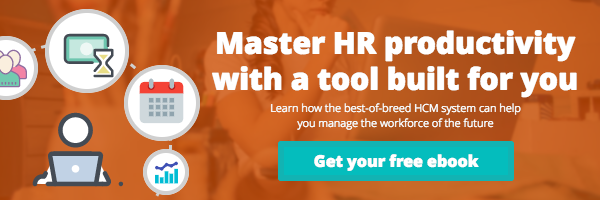
In an average day, many HR managers have a staggering number of tasks to accomplish. Between reviewing resumés, training new hires, and interacting across teams, it may feel like time is not on your side. With the amount of work that needs attention, it can be tough to keep up. You need to be able to respond quickly, embrace change, and thrive in disruptive environments.
Enter: Agile
Agile emerged as a software development method designed to optimize responsiveness, productivity, and efficiency. In 2011, a team of software professionals sought to create a better approach for software development. This resulted in the Agile Manifesto, which defines some of the key principles of agile:
- Individuals and interactions over processes and tools
- Working deliverables over comprehensive documentation
- Customer collaboration over contract negotiation
- Responding to change over following a plan
Today, the agile approach connects everyone and everything together while delivering instant value on a large scale. Under this approach, tech giants like Amazon, Apple, Facebook, and Google built large, innovative empires at full speed. And more companies are starting to adopt it. According to PMI's project management survey, 71 percent of organizations embrace agile as a method for managing projects. And findings from Deloitte suggest 94 percent of surveyed organizations with agile and collaborative practices generate more successful project performance.
Developments with ongoing technology, demographic changes, and policy changes are impacting HR outlook. This means working efficiently and productively is necessary to reduce the time, money, and resources to meet the objectives. Rigid plans and systems won’t cut it in today’s fast-paced environment. Like agile organizations, HR must enable flexibility and efficiency in processes across different teams and departments.
But what does agile look like for HR?
To start, let’s define agile for HR
To put it simply, agile is a project management approach that uses sprints, prioritization of tickets, and periodic feedback. Using this approach should bring flexibility and efficiency to teams and hiring managers.
Let’s take a look at how this manifests into four areas for HR:
Recruiting
Part of agile is about fast feedback as a way to clarify requirements for projects or tasks. When reviewing resumes, constant feedback cycles can help both the recruiter and the hiring manager discover unknown requirements. In this instance, they work together to reevaluate job descriptions or adjust screenings. The outcome is finding the best possible candidates while reducing bottlenecks in the process.
Inconsistent knowledge and information flow between departments can be time-consuming and burdensome. Making your work visible provides transparency in the developmental process. With information flowing in a fluid network, the teams learn about the business, culture, and involved skills as well as the complexity of the projects. Throughout this process, managers can divide resources and prioritize tasks.
Training
Say goodbye to periodic training programs! Agile encourages continuous learning and development rooted in everyday work. The agile environment puts emphasis on e-learning, informal development, and fast re-skilling. Best practices are shared and improved by teamwork and collaboration with informal, peer-to-peer development processes.
Organizations also have a suite of online learning modules so employees can access information on demand. To identify skills for a particular job, using data aligns training with each employee for areas of improvement. Although goals guide individual job roles, they should also support organizational goals to scale impact. With greater flexibility in learning, employees may stretch themselves to embrace more opportunities outside of their roles.
Performance
Agile is moving performance reviews to forward-looking, real-time feedback. With a focus towards future growth, the agile method enables both the employee and the organization to evolve and work towards business goals. Incremental work encourages a team-based culture where groups define the requirements, processes, and management. In this way, groups track their own progress, identify obstacles, assess leadership, and produce insights.
When employees operate independently, managers enter the role of the coach instead of taskmasters. In agile, managers establish employees’ priorities and goals, provide feedback, and help align employees’ capabilities and relationships with company needs and objectives. For coaches, it’s important to have a visual management system to manage communications and goals. Robust reporting and management tools can trace and report interactions and performance indicators.
Payroll
Employees are growing out of traditional compensation. Because annual raises take too long, employees receive spot bonuses instead of end-of-year salary increases. Short-term incentives drive productivity and motivation for the company's bottom line. As employees adopt more difficult or nuanced projects, they may receive higher compensation.
Today’s workforce thrives on balance-focused benefits like flexible work hours and sponsored sabbaticals. By adopting an incremental approach to payroll, compensation is more manageable. Managers should tailor the system to fit the needs and goals of employees in pursuit of company culture and growth.
Finding the sweet spot
Even though agile is a process originally created for software development, its methods are transforming the way things get done—even in human resources. But transitioning from a traditional approach to agile HR methods takes commitment and effort. It’s best to evaluate your company’s process and determine how agile practices fit in with your project management framework. Give your organization the best support and opportunity for success by having the right tools ready and the knowledge for future growth.
For more productive tips made for HR managers, download our ebook to improve HR productivity with an HCM system.

